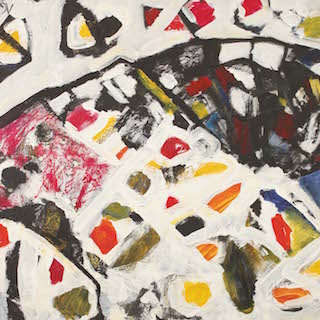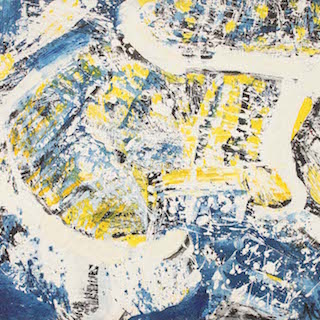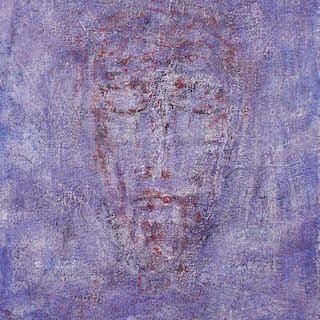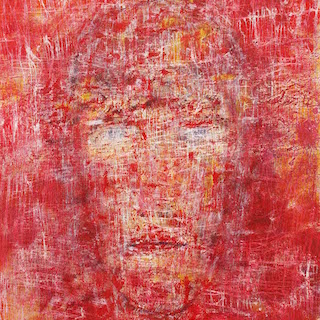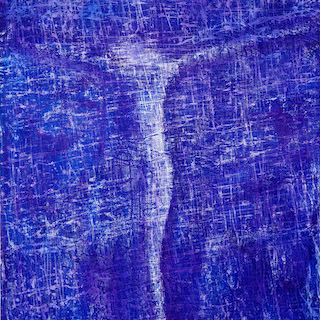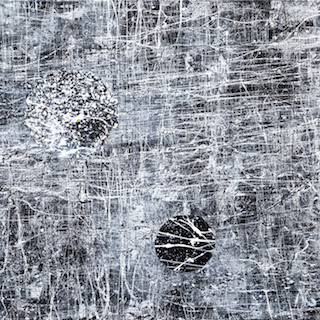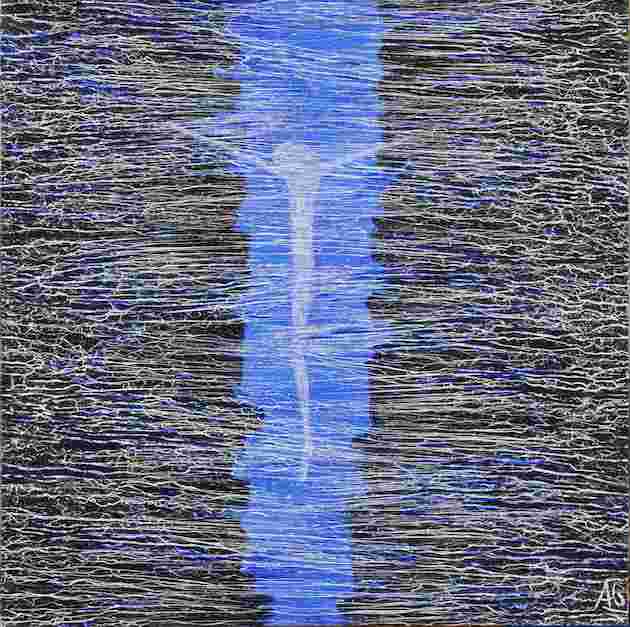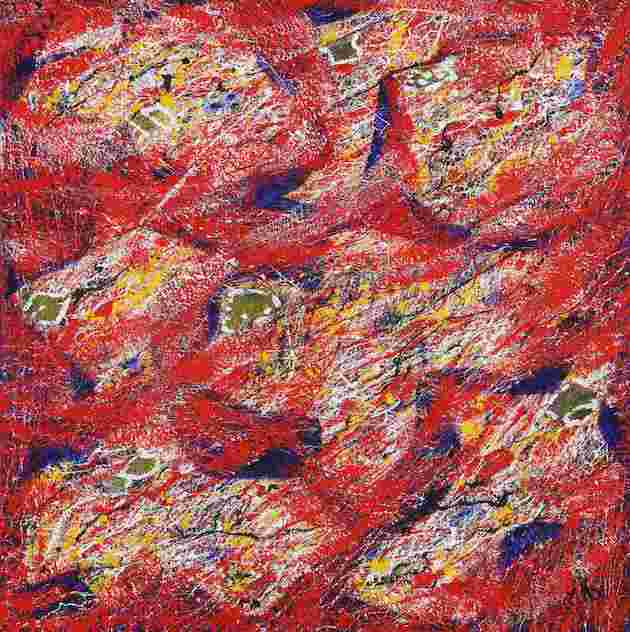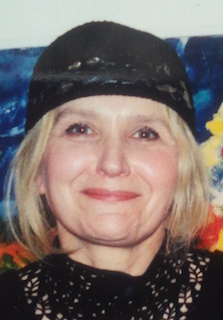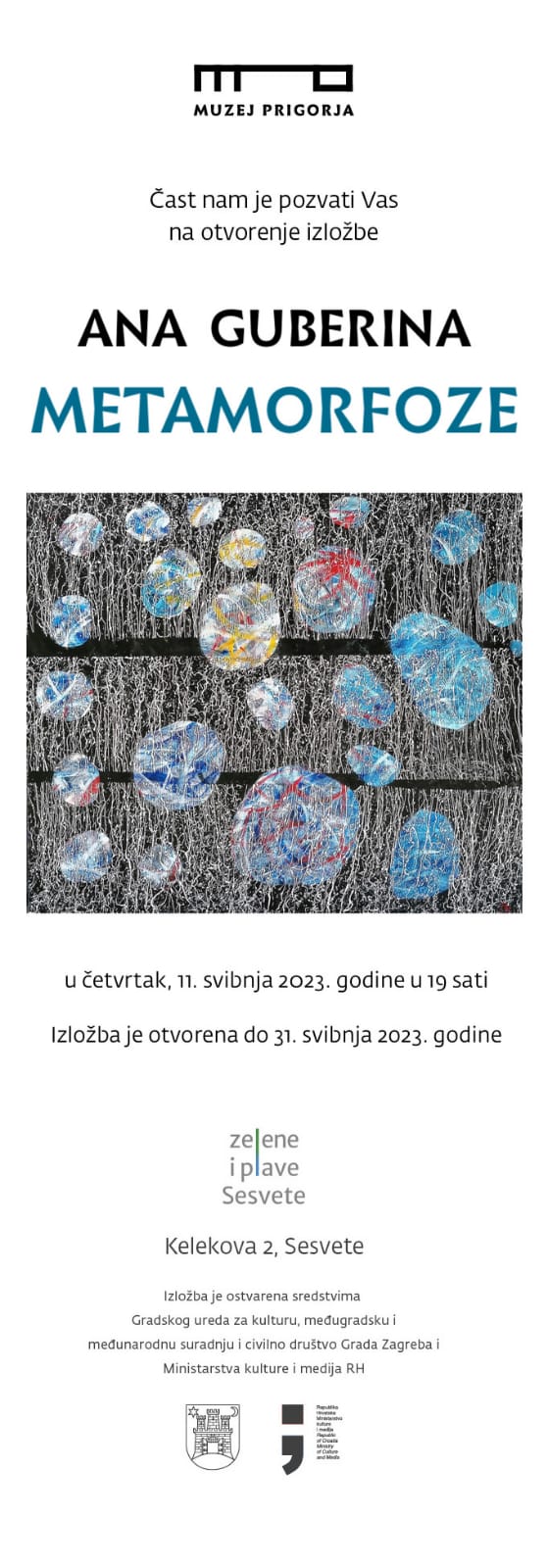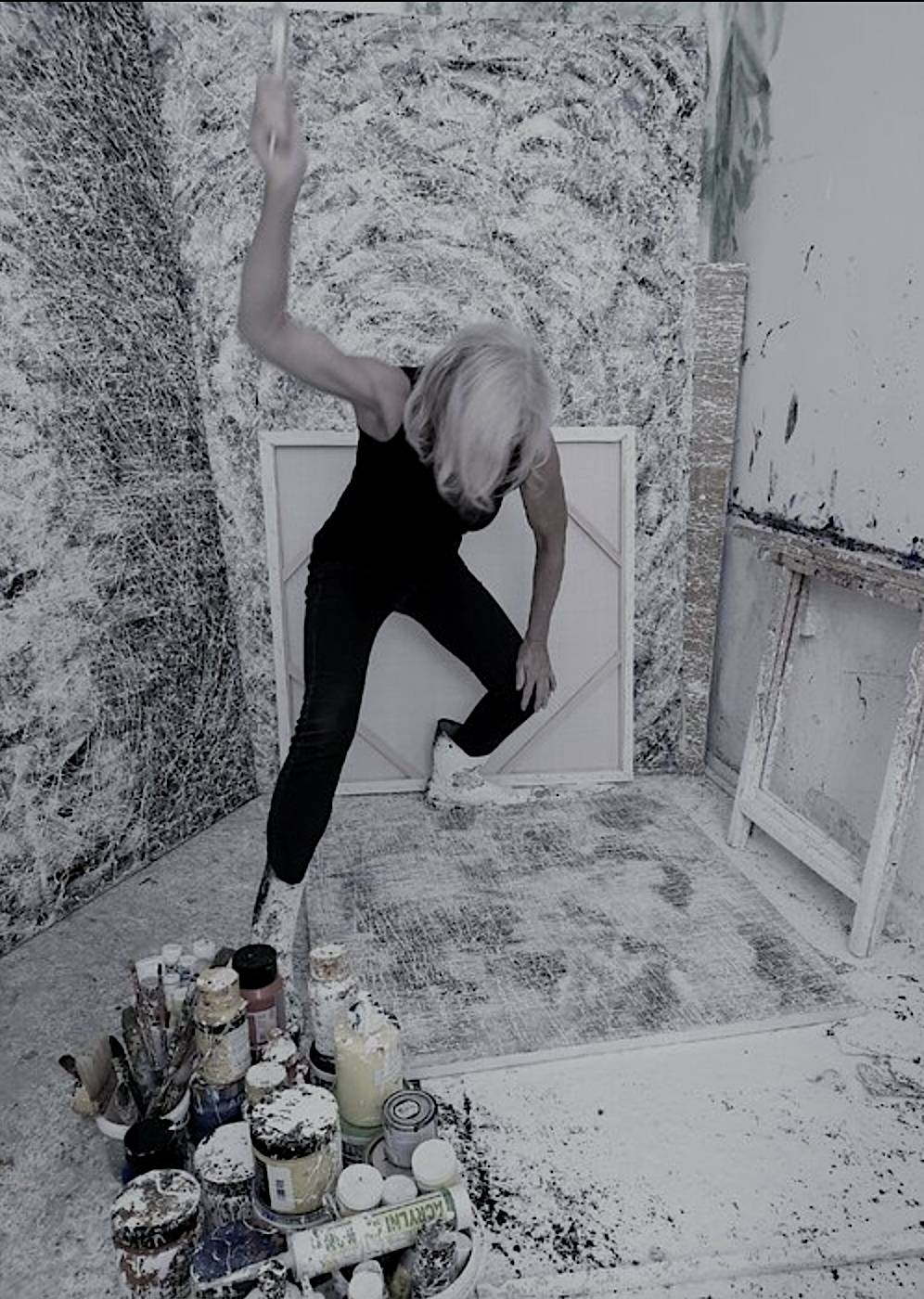Ana Guberina's religious Painting: A Pilgrimage in the Christocentric Universe
Without any pretence and with all certainty it is possible to establish that Ana Guberina does not have a comparable competitor in the Croatian painting when the encounter of religious experience and kinetic gesture and their interconnectedness is concerned. Not only kinetic, but also dynamic. This gesture is expressed by means of profuse dynamics mostly because it is not caused merely by a movement, an impulse of force in the spirit and hand - but the painter's entire being has been able to make real and to transfuse hidden stimula of the most intimate existential manifestation to a permanent impetus. Spiritual inclinations, individual and deeply personal, are grasping the general and universal. A microcosm and macrocosm in a particular anthropologic and cosmic dialectics.
These forceful creative impulses that emerge from hidden landscapes of the soul could conveniently be called intuition which, in terms of Aristotle, appears as lucky, and in this case dexterous combination of instinct and intellect. And we can give them an even more appropriate name: qualitas occulta. It is a unique bond with the transcendent, with the Almighty, with God in Three Persons and Trinitarian God, and Saint Augustine talked about him as of "innermost inner self". Existentialist feeling of being thrown into the world, the feeling of not having foothold and of pointlessness, was transformed, in the Christian existentialism - which Ana Guberina makes present and presents on her canvasses with credibility - into theocentric, in other words Christocentric orientation of senses: faith and hope, loyalty and love.
Ana Guberina's preoccupations in terms of motif and theme are motivated and inspired by God's existence and touched and imbued with His life-giving mercy. Here, the visual text consists of densified and tensed, freed and dispersed infinitesimally tiny breath particles, pulsing and far-reaching, which are produced in structured swarms and longitudinal waves. A delicate shudder and powerful inrush of creative energy mediated by mercy.
It is necessary to say that utter reduction of subject-matter is part of Ana Guberina's religious painting and here, the representational gives way to the enounced. However, the motif has not completely disappeared, it is still pulsating with its inner lines of force which dynamise and keep together the elements of a discernible and unique scene. Nevertheless, the rhythm is not in the motif, but in the visual text. In the static quality of the motif, colours and forms vibrate animatedly, in which process the implicitly indicated forms, allusive and synthetic, result from the painter's formatively administered colours and return into these colours with self-confidence.
Symmetry is not rarely dominant in the paintings by Ana Guberina, and this symmetry is made alive in a particular manner by the rhythm; it is brought into resonance with the ever-changing world. Textures of the lines, created by means of forcefully thrown colour, are interlaced traces of dynamic gesture: it is a kind of action painting, a combination of exhilaration and sedateness, dispersiveness and straightforwardness, instinct and intellect; here, the flying quality of lines is interwoven, these line entwine pictorial micro-fragments thus creating dynamic structures of various morphologies and broad expressive registers, from burning and bright colours to refined chromatic reductions. Vehemently thrown colours, mostly achromatic, have spurted over the canvass creating a rich variety of trajectories, with their starting point connected. These trajectories are of tense linearity, of flexible sinusoid undulation, of spiral vortex-like quality, with their flying and interwoven features visible. The observer's attention is caught in grid-like fabrics of this unique dynamic gesture.
Dematerialisation of the material and abstraction of the subject-matter make the assimilated actualities stronger; reality is expressed more faithfully, better to say the truth, constitutive and absolute, that belongs to this reality. Really, the painter's handwriting, in its seeming asemantics, reaches towards the fullness of the truth. From these synthetic expressive lines, Ana Guberina has woven an extensive cosmos with Christ at its centre.
Although in such occasions one usually mentions artistic creation, it is more appropriate to talk about artistic act as translation from potentiality into actuality. Aristotle used the term dýnamis in order to denote potentiality, possibility, viability which together with actuality, reality, in other words, act, from the Greek enérgeia, create a metaphysical dichotomy, a duality that exists in the relationship between opposition and undeniable orientation of one towards the other.
Namely, in strict terms, only God can create. Only the eternal and omnipotent Creator does what is impossible for the mortal - with his word, he calls from non-existence into existence (creatio ex nihilo). And he does it all the time: the world keeps turning owing to the continuous God's creation (creatio continua). And so, God makes the world exist, always the same and at the same time, always new. He does it by means of the unique dialectics of genesis and mimesis.
Ana Guberina is among truly rare painters who managed to remove themselves from mimesis, from figuration, but without its complete dismissal; she has retained a sentimental secret understanding (or, better to say secret visual contact) with this figuration. Here, she has rather chosen, on the wings of imagination, extensive and sacramental spaces of the spirit where the words of genesis or creation reach from the ancient past as a kind of echo. Relations between genesis and mimesis, complex and including numerous conditions, are discernible, among other, in the painter's cycle about Adam and Eve. In this cycle, duality of female and male, but also dualities of the heavenly and earthly, of abstract and figural, of the enounced and presentational, of intelligible and sensible, of universal and personalising, of transcendent and this-worldly, and of eternal and transient meet, interweave, and are in dialectic conjugation in both spirituality and corporeality.
Primogenitors Adam and Eve misused the given gift of freedom and broke the life-giving connection with God, The Creator. As a punishment, they earned mortality. Because of that, "the second Adam" took on human nature in the perishable body, God and Man Jesus Christ, who is the Word of God: ...In Him was life, / and that life was the light of men" (The First Epistle of John 1 : 4). Christ is the source and destination of all the existing, to which all is directed, finally "so that God may be all in all" (The First Epistle of Paul the Apostle to the Corinthians 15 : 28).
The path to completion, where God will be "all in all" is an entirely unique pilgrimage. It is not only earthly, but above all it is cosmic. This religious journey - one and only and one time and only - is made not only by pilgrims, but also by the entire out-of-man nature, living and non-living, the entire universe. All that exists takes on this pilgrimage to That who said for himself: "I am the way, and the truth, and the life." (The Gospel According to St. John 14 : 6). Jesus is the Way because he is the only one who declares his Father's name and shows how to come to Him; Jesus comes from his Father and comes to his Father, and is one with Him at the same time. Ana Guberina perceives shrewdly that what we find in the works of the famous Jesuit, philosopher, theologist, and palaeontologist / scientist Pierre Teilhard de Chardin: cosmic moving towards the "Omega Point" is much more credible and much more important for the Christian religion than pilgrimage shrines and destinations as well as transformative potential of pilgrimages which are, in phenomenological and cultural terms, subjects of anthropologists (especially of Victor and Edith Turner).
De Chardin aligned the Original Sin, committed by primogenitors Adam and Eve, with natural sciences and here, the beginning of man is explained as evolution which teleologically, in other words, with aim or purpose, moves towards the space of ideas, the so called Noosphere, and further on towards the "Omega Point", and this is no less than fullness of the universal cosmic Christ where "God may be all in all". With this, de Chardin elevated embodiment to the cosmic level, pointing out that the man will join God in the point of spiritual perfection, in the "Omega Point". Such a Christ-aiming evolution should be understood as a unique and unrepeatable pilgrimage.
The paintings from Ana Guberina's cycle Coherence tell us convincingly that seeking closeness to God does not have to be primarily connected with the earthly topographies or toponyms, with sacred places or shrines, but with fulness of the idea which, although it may seem as contradictio in adjecto , is centred in its cosmic all-presence. Such an understanding is supported by the words of Jesus, which follow after the Samaritan woman asks whether they (Samaritans) should worship "on this mountain" or "in Jerusalem". Jesus, namely, answers: "...the hour is coming when neither on this mountain nor in Jerusalem will you worship the Father." [...] But the hour is coming, and is now here, when the true worshipers will worship the Father in spirit and truth..." (The Gospel According to St. John 4 : 20-23).
Titles of some of her paintings clearly say that the artwork of Ana Guberina is strongly connected with the Gospel and the related Christian religion and symbology, as well as that it is inspired by the Christocentric thought of the Jesuit Pierre Teilhard de Chardin - who talked about the all-present power of God's love that keeps the entire universe together, centred in Christ who is love that connects all the dimensions and levels of existence and guides them towards completion and celebration in the "Omega Point", and these titles of paintings are: Adam and Eve, Coherence, Is the Universe Christocentric, Heading Towards Omega, Centring, Pilgrim, Walk to Emmaus, Meditations, Sacrament of Eucharist, Oh My Lord, Oh My Lord, Why Have You Left Me?, Here, I Do Everything New!
It is discernible in the paintings of Ana Guberina exhilaration brought about by the Gospel message, but also a modest religious composedness. This is artistic co-creation of reality, in other words, translation of its significant constituent parts from potentiality into actuality. Afront new and more far-reaching perspectives of Ana Guberina's action painting, her desire for Christ who is the centre of the entire universe, cosmos, everything that is and that has potentiality to become and to be is more and more prominent.
Exactly here, one can find the Christian power and credibility of the oeuvre with which Ana Guberina enriches the Croatian religious painting. Due to this, a lucid remark made by the historian of art Ivo Šimat Banov that there are many sacral works without true religiousness while on the other hand, some entirely abstract and non-sacral compositions include true religiousness can be applied on Ana Guberina's paintings.
Without any doubt, the artwork of Ana Guberina is "an entirely another art" (un art autre), an authentic artistic expression of the otherworldly and ungraspable; it is a painting expression within which traces of dynamic gesture pulsate, existing in semantic resonance with the words of Christ and the founding truths of the Christian religion.
Marito Mihovil Letica










